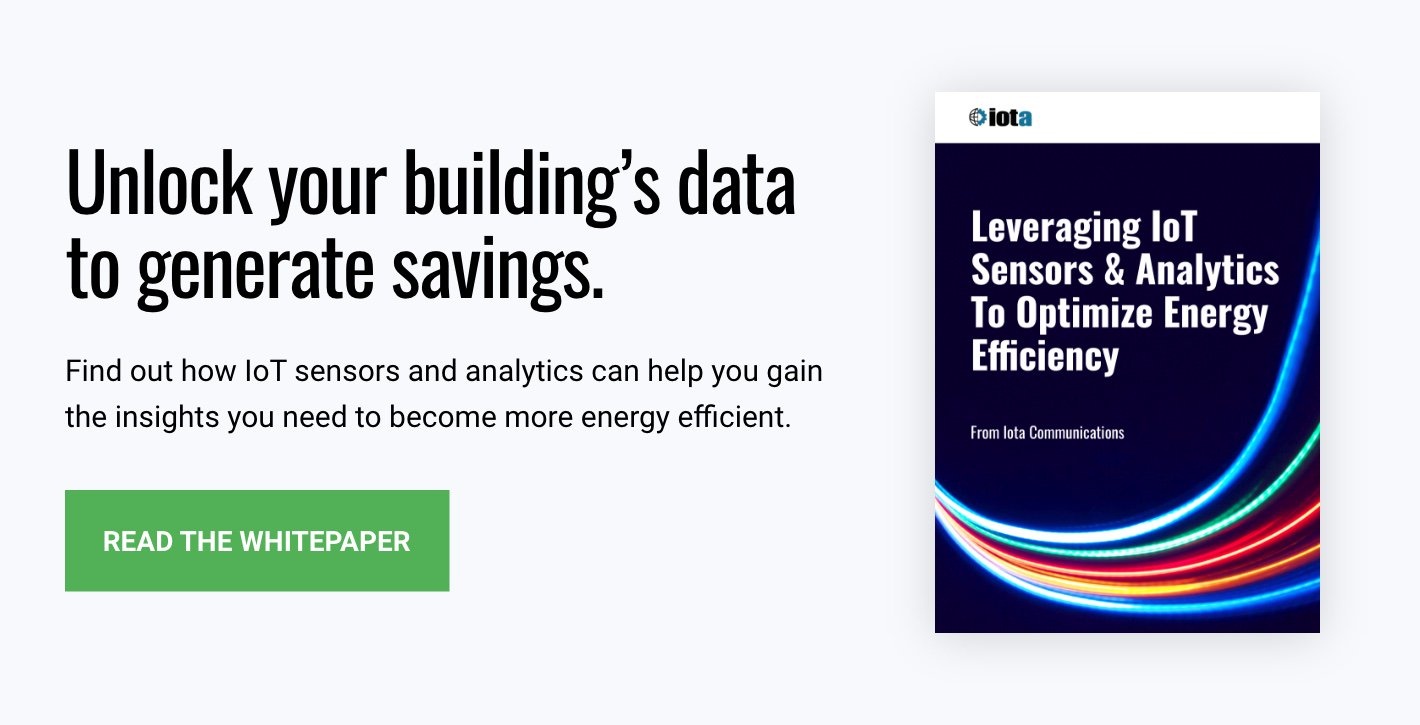The facilities management (FM) profession is changing—and has been for the past several years. According to an article that recently appeared in FMJ Magazine,
“…the work of FM is no longer just about managing the facilities—it’s about how FM is creating organizational and strategic value.”
What does that mean? The same article explains: “That means becoming adept at using technology and data to deliver advice, insights, and new services to the workplace.” It calls out the Internet of Things (IoT), in particular, as being a driving force behind this new approach, giving facility managers a better way to understand, evaluate, and—hopefully—improve building environments.
In order for any IoT-based environmental monitoring approach to fulfill those expectations, it must include the following:
- A way to monitor the environment.
- A way to measure the collected data.
- A way to catalog the data.
- A way to provide actionable insights based on data analysis.
[bctt tweet=”The better your system of monitoring, measuring, and cataloging data, the better you’ll understand the story of your business—and the better your insights will be.” username=”iotacomm”]
In this article, we’ll take a closer look at each of these elements and how they come together to help today’s FMs provide new, higher-value services that actually enhance both the environment and the business.
Environmental Monitoring: 3 TypesEnvironmental monitoring for buildings gives facility managers an in-depth understanding of the environmental aspects of physical buildings and/or work areas, including:
|
IoT-based Environmental Monitoring: 4 Essential Components
1. Monitoring The Building Environment
Data-gathering forms the foundation of all IoT environmental monitoring systems, and the data you collect must be accurate and measurable (see the next step for an explanation of measurable data).
Monitoring the environment for purposes of gathering operational or performance data requires outfitting your building with IoT sensors. IoT sensors can monitor just about any aspect of the physical world with great accuracy. It’s possible to deploy sensors to gather data on everything from temperature and air composition to water quality, light levels, and more. And because they capture data remotely, they can be located far away from systems that ultimately organize and catalog the data. They transmit the data they collect to a server in the cloud via gateways.
Often, sensor data is tasked with capturing information relevant to a particular task, so the data can be used to make process improvements for the purpose of saving money or increasing efficiency.
2. Measuring The Data
Sensors collecting the data and cloud-based analytics measure it, assigning it real-world values so it can be interpreted and used to derive insights. Physical world measures such as volume, flow, acceleration, saturation, etc. are characteristics with a spectrum of analog values that could range from zero to infinity. Think of it like the speed of a car—it’s not helpful to simply know you’re going “fast,” but it is useful to know you’re traveling at 80 miles per hour. In the case of environmental data, sensors may measure certain pieces of data and assign them a specific, measurable number of amps and volts, so you can then use a mathematical formula to calculate kilowatts—a designation that is useful for understanding your building’s energy consumption. Similarly, the concentration of harmful chemicals in the air could be used to establish threshold alerts to warn occupants.
The analog data collected from the physical world must then be translated into digital data, which makes it possible to transmit it over the network and into the cloud (where you can then access it on your computer).
3. Cataloging The Data
Cataloging is essentially the process of assigning context to the data you’re mining, helping you to ultimately answer the question, “What am I looking at?” The IoT is able to provide context by aligning the data points and actual measurement values in a statistical or analytical model. Cataloging of the data provides a framework to better understand the relationship of variables by organizing the data in a quantifiable format.
Data cataloging is more easily understood with an example. In the book Big Data by V. Schonberger and K. Cukier, the authors described datafication as the process of organizing and indexing data in a quantifiable format. They point to a Naval officer Maury, who in 1839 developed a process to standardize the logging of nautical data, such as barometric pressure, compass, and sextant data, to improve navigation and sea travel efficiency. It wasn’t until all these points were brought together that their relationships could be examined as a whole and the data interpreted in a way that was useful. In this manner, the cataloging of data serves to develop an enhanced platform for data engineering schema layout, and data blending for analytics and machine learning.
Today this concept is also called “datafication.” In the case of facility management, IoT-based environmental monitoring means transforming your otherwise invisible building characteristics into quantifiable data points, and then juxtaposing those points in relationship to other endeavors going on inside an organization.
Looking for a simple way to get started with IoT environmental monitoring? Set up a discovery call with us to see how easy it is to get up and running with our remote monitoring service.
4. Performing Data Analysis For Insights
While the sensors provide access to the data itself, and measurement and cataloging help put the data in a usable form, a crucial piece of the process remains how to gain insights from the data. Even with an abundance of great data, if you can’t act on it, then it probably isn’t worth your time to collect it in the first place.
Many IoT environmental monitoring systems have an advanced analytics component that helps you unlock real business value from your data by providing two things:
- Perspective—Your system can provide millions of data points, but what do they mean from a big picture perspective? You need an overview of what’s going on in your building environment. In many cases that means understanding the magnitude of the impact of a measured value. For example, if you’re capturing data on carbon monoxide and the levels have historically been rather benign, an elevated measurement would certainly stand out. But how important is that occurrence? To determine that—and to determine how best to respond—you need to be able to compare it to historical data. Putting that particular data point into perspective will help you know if you need to make a structural change to address it, or if it was a one-time occurrence that may have happened before under similar circumstances.
- Context—In the same fashion, you need to have context surrounding your data that helps you interpret it. For instance, if you monitor certain environmental aspects and benchmark the data (compare it to industry bests or even other buildings in your portfolio), you’re better able to determine its significance. By the same token, if you’re capturing specific data in a steady fashion, you can establish alerts and alarms that will help you respond in certain circumstances. Those alerts can be developed through analytical models or standard statistical relationships, giving you sufficient time to react and potentially avert a detrimental—costly or dangerous—situation.
With the right context and perspective surrounding your data, you can take anticipatory steps (forecasting) that will help you mitigate risk. You can also align your data collection and analysis with company performance objectives, so you’re playing an active role in working toward larger organizational goals like reducing operational costs or achieving sustainability goals. The more data points you can capture, the better forecasting you can do, as long as you have a way to understand data relationships and variables and a system for incorporating the data into your organization’s decision-making.
Looking for a simple way to get started with IoT-based environmental monitoring?
Talk to us at Iota. Our goal is to help facility managers and businesses derive valuable insights from IoT monitoring. We’ll work with you to identify your goals, discuss opportunities where real-time data can be valuable, and set you up with an environmental monitoring system that’s both cost-effective and easy to use. And we’ll be with you every step of the way, offering guidance on ways to optimize your data and your building operations. Reach out to us today and let’s get started.


